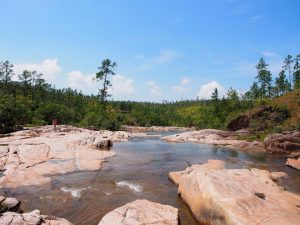Today we set up camera traps throughout the forest neighboring Las Cuevas. The entire process took all day, from 10 am until 1:30 and then 2:30 to 7:30. Needless to say, the process exhausted me. Hiking on and off trail in a humid tropical environment for hours on end is certainly different from the comparatively cushy lifestyle of an American college student.
About a third of the way through the endeavor, another student proposed that we shorten the distance between camera traps so that we can set up more in a given amount of time and head back earlier. I supported the motion but the class did not. So we marched onward.
By the time we were halfway through, my boots felt so heavy that I wasn’t even walking, I was just swinging them over the ground with each step, hoping that I did not hit anything. I was panting and completely drenched in sweat. “Damn, I am out of shape,” I thought as my classmates marched onward. Despite my desperation to stop, I marched onward too. I didn’t really have a choice.
Hours later, we made it back to the station. Although I stayed well hydrated in the field, I had a splitting headache and could barely stabilize myself when I was standing upright. I had reached my limit.
As an economics major, every moment I had to think on the trail, I spent trying to calculate the expected value of moving onward. I tried to compare the benefit and probability of seeing an interesting animal with the benefit of calling it quits. I never thought it all the way through, though. I was too damn exhausted.
Despite causing me so much physical despair, the hike granted me many gifts – yellow prickly trees (Zanthozylum spp.), monstrously large strangling figs (Ficus aurea), Mexican porcupine, green tree anole, tommygoff snake, a Mexican tree frog, abundant lianas reaching up to the canopy. The yellow prickly were numerous and had sharp spines, an adaptation to keep away herbivorous arboreal megafauna. The largest strangling fig I saw completely overtook its host tree and was hollow on the inside. The Mexican porcupine I saw was climbing the tree through this hollow interior. The most vivid encounters were with blue morpho butterflies (Morpho spp.), whose radiant sapphire blue wings contrasted greatly with the browns and greens of the understory.

Today pushed me to my limits, but it also awarded me with many of the rainforest’s treasures.
The first principle of economics is that there are trade-offs. Despite my incomparable exhaustion, I am satisfied with trading off comfort for adventure. That’s why I came to Belize.




































